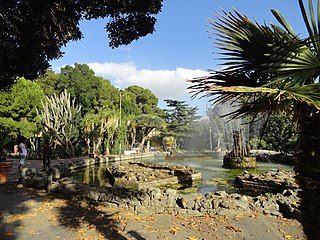
The Villa Giulia is a villa in Rome, Italy. It was built by Pope Julius III in 1551–1553 on what was then the edge of the city. Today it is publicly owned, and houses the Museo Nazionale Etrusco, a collection of Etruscan art and artifacts.

The University of Palermo is a university located in Palermo, Italy, and founded in 1806. It is organized in 12 Faculties.

Casteldaccia is a town of 11,628 inhabitants and comune near the Metropolitan City of Palermo, Sicily, southern Italy, founded by Marquis Longarini. It is the seat of the Vini Corvo wine producer, and the Tomasello Pasta factory.

The Villa Spedalotto is the country home of the Paternò di Spedalotto family. The villa is situated on a hill surrounded by olive groves at Bagheria, near Palermo in Sicily. As all the Villas in Bagheria, it was built as a country house, and was traditionally used by the family only during the spring and autumn. While considered a national monument, it remains a private residence.

Palazzo Ajutamicristo is a Late-Gothic and Renaissance-style aristocratic palace located on VIa Garibaldi #23 of the ancient Kalsa quarter of Palermo, region of Sicily, Italy. It rises about a block south of Piazza Rivoluzione.
Quattro Canti, officially known as Piazza Vigliena, is a Baroque square in Palermo, region of Sicily, Italy; it is considered the center of the historic quarters of the city. The site is the intersection of two major streets in Palermo, the Via Maqueda and the Corso Vittorio Emanuele, and at this intersection are the corners of all four of the ancient quarters of Palermo: the Kalsa (SE); Seralcadi (SW); Albergaria (wW); and Castellammare (NE). On the southwest corner stands the church of San Giuseppe dei Padre Teatini. A few steps away along the flank of this church, behind the Southeast corner building, along Via Maqueda is the Piazza and Fontana Pretoria, sandwiched between this church and Santa Caterina. A few more steps reaches San Cataldo and the ancient Norman church of La Martorana. About 500 meters west along the Cassaro is the piazza of the Cathedral of Palermo and the adjacent Palazzo Normani.

The Villa Palagonia is a patrician villa in Bagheria, 15 km from Palermo, in Sicily, southern Italy. The villa itself, built from 1715 by the architect Tommaso Napoli with the help of Agatino Daidone, is one of the earliest examples of Sicilian Baroque. However, its popularity comes mainly from the statues of monsters with human faces that decorate its garden and its wall, and earned it the nickname of "The Villa of Monsters".

Palazzo Isnello is an historic palazzo situated between the ancient via del Cassaro and Piazza Borsa, in the Kalsa quarter of Palermo, Sicily.

The Genius of Palermo is one of the city symbols and the lay patron of Palermo. He was the ancient numen and genius loci of the Sicilian city.

Ignazio Marabitti was a Sicilian sculptor of the late Baroque period.

The Villa Giulia, also known as Villa del Popolo, and as Villa Flor is an urban public park, lying to the east of the Botanical Garden of Palermo, in the region of Sicily, Italy.

The Garraffo Fountain is a Baroque fountain of Palermo. It is located in Piazza Marina, down the ancient Cassaro street, now called Via Vittorio Emanuele, within the historic centre of Palermo.

Villa Malfitano Whitaker is a 19th-century villa in Via Dante, in the quarter of Politeama of Palermo, Sicily. It is presently a museum displaying Whitaker's natural history and archaeological collections, as well as his artwork.

The following outline is provided as an overview of and topical guide to Palermo:

Sant'Eulalia dei Catalani is a deconsecrated church, whose Renaissance facade can still be seen on Via Argenteria #19, at the edge of the lively Vucciria market in ancient quarter of Castellammare in central Palermo, region of Sicily, Italy. In a niche in the small piazza in front of the church is a statue of the Genius of Palermo, sculpted by Pietro di Bonitate in 1483, and now called Palermu lu Grandi.

The 4th Engineer Regiment is a military engineer regiment of the Italian Army based in Palermo in Sicily. Today the regiment is the engineer unit of the Mechanized Brigade "Aosta".

Kanaris at Chios, also known as The Kanaris brothers or The sailors of the English Garden, is a marble sculpture completed by Benedetto Civiletti in Palermo, Sicily in 1878. It represents Konstantinos Kanaris and Andreas Pipinos at Chios, as they were sailing on board a fireboat towards the Ottoman flagship of admiral Nasuhzade Ali Pasha. This event, known as the burning of the Ottoman flagship off Chios took place on the night of 18 June 1822 during the Greek War of Independence, and was a reprisal for the Chios massacre which occurred two months earlier. Two thousand Ottoman sailors were killed, including Nasuhzade Ali Pasha himself.
Villa Filippina is presently an urban public park and host to various cultural events, with one entrance on Via Villa Filippina, facing the park in front of San Francesco di Paola, in Palermo, region of Sicily, Italy.

The Piersanti Mattarella Park, formerly the English Garden, is a public park in Palermo designed in 1851 by the architect Giovan Battista Filippo Basile.

















